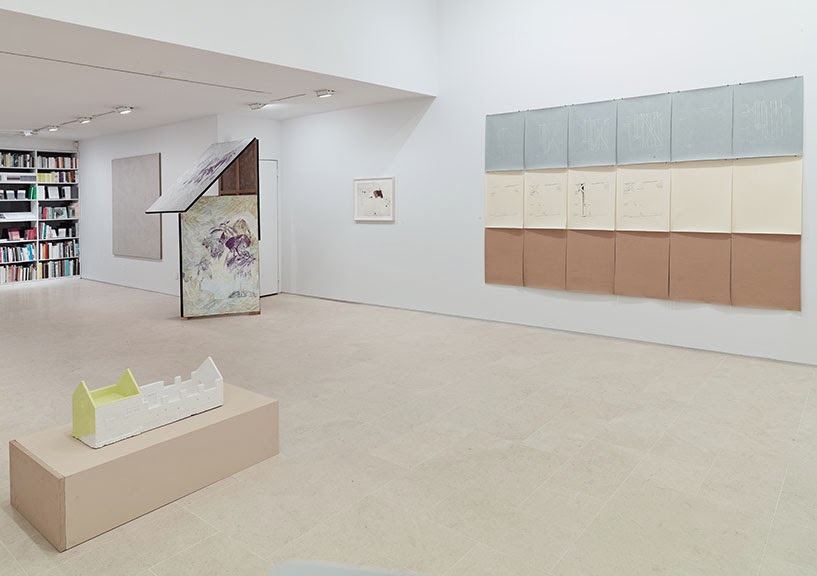
Contributed by Sharon Butler / In his first solo show, at Miguel Abreu, 2012 Bard MFA grad Dustin Hodges presents a series of compelling architectural drawings, some gestural paintings of houseplants, an architectural model made of Styrofoam, and a kiosk constructed from stretched canvases. At the entrance of the gallery, a large piece (I hesitate to call it a painting), made of stretched linen, hangs to the left. Looking closely, I began to see that the linen isn’t blank; in fact, a faint image of what appears to be a partial axonometric projection grid is lightly drawn in pencil across the surface. Unlike the linear perspective grid more commonly used by artists, the lines in such projections don’t converge at the horizon, so images created with them may seem less realistic on the page, but they are more precise in terms of scale and measurement. Although Hodges titles the piece Axonometric Projection, the name isn’t accurate–for axonometric projections, the grid would be at a 45-degree angle. The architectural reference, promising a rational outcome, is a bluff–don’t fall for it.
Further inside are two drawing installations, pinned to the wall in a grid format. Rendered on ivory, brown and blue-gray sheets of paper, the drawings begin with the underlying pencil grid (as seen on the large linen piece), and bits of architectural detail are inked in on top. The few austere gestural houseplant paintings seem to be included to warm up his faux architectural work, the way actual plants
make a room seem more alive, less industrial.
In recent years many painters have taken painting in a sculptural direction, but Hodges has gone a different route, bringing drawing devices and materials into the arena of painting. Like Hodges, I’m fascinated by the putative gap between drawing–in particular, architectural drafting–and painting, and in narrowing it to the point of convergence. Can a pencil rendering on canvas be a painting? Can drawing devices like perspective grids and projections be subverted for emotional affect? Is there any sense to stretching drawings on large swaths of canvas as if they are paintings? I would answer these questions in the affirmative. I believe Hodges would, too. Viewers are often disappointed in the lack of paint in work like his, but they could just as well apprehend it as enhanced drawing as they might regard it as enervated (or unfinished) painting. Architectural drawing is supposed to be a factual prescription for real arrangements. Yet in using its systems and tricks unconventionally–indeed, incorrectly–Hodges imparts expression and emotion that would not otherwise be there.
According to the press release Hodges has created a narrative about a fictional movement (or tendency) called “Late Stick Style,” in which a semi-authorless vernacular, primarily concerned with “expression of structure,” developed in American wooden architecture in the 19th century, but the conceptual conceit doesn’t make his exhibition more interesting. I prefer to wonder what he had in mind, and simply build my own narrative around his compelling framework.
“Dustin Hodges, Late Stick Style,” Miguel Abreu, LES, New York, NY. Through February 23, 2014
About the author: Sharon Butler is a painter and the publisher of Two Coats of Paint
Related posts:
Architecture as muse at Union College
Looking back: Precisionism, Part I (2012)
Gone Wrong (2012)
——
Two Coats of Paint is licensed under a Creative Commons Attribution – Noncommercial-No Derivative Works 3.0 United States License. For permission to use content beyond the scope of this license, permission is required.























